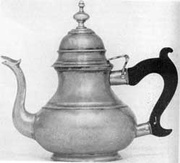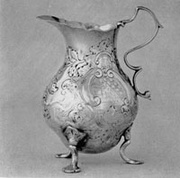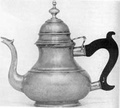This article details the silver plate that belonged to Captain Tobias Lear, the father of George Washington’s secretary (and close friend) Colonel Tobias Lear. It describes the various pieces in the set and identifies the manufacturers using the makers’ marks. It originally appeared in the December 1937 issue of American Collector magazine, a publication which ran from 1933-1948 and served antique collectors and dealers.
It is a matter of general observation that in this country family possessions tend to become scattered in the course of a few generations. Division through inheritance and the normal rate of disposal and loss have their share in this rapid dispersion but more is due to the American habit of shifting domiciles with a frequency greater than in any other part of the world. Hence it is a rare event when more than a few pieces of furniture from the same estate remain together after 150 years unless, by some fortuitous chance, they have been kept in the house for which they were originally obtained.

The Lear Coat of Arms: The crests on the silver were probably done from this rendering then owned by the Lear family.
This regrettable dissipation seems especially virulent with old silver. It is so easily portable; so readily convertible; and, once-separated, seldom indeed are the various objects ever again brought together.
Recently, however, a group of old silver was assembled where the pieces were not only interesting in themselves but had an unusual historic association since all had belonged to Captain Tobias Lear, the father of Colonel Tobias Lear, George Washington’s private secretary and trusted friend. As the Captain died in 1781, it is really remarkable that so much of his plate could be brought together and, actually, the opportunity occurred almost by chance.
No other house in New England can boast of such a long and close connection with George and Martha Washington and their families as the old Lear home on Hunking street in Portsmouth, N. H. For practically 16 years Colonel Lear lived as a member of the Washington household, being regarded almost as an adopted son. Two of his wives were nieces of Martha Washington. Concurrently, an intimacy developed between the families which spanned three generations and extended 60 years.
Two years ago the venerable house was on the point of collapse. Fortunately it was taken over by the present public-spirited owner, a man who is holding it until sufficient funds are secured for its acquisition by the Society for the Preservation of New England Antiquities. Meanwhile, it is open to visitors during the summer months and is gradually being restored to its original condition. Work on the interior has already been completed, so that it now presents much the same appearance it must have had when Washington made his famous call on Madam Mary Lear, his secretary’s mother, in the autumn of 1789.
Much care has been taken to secure the desired effect and fortunately many of the original furnishings could be located for study. In the course of these investigations, pieces of the Lear plate kept turning up and finally it was found possible to assemble and photograph them. In all, 19 pieces were located. Eight were early American and the balance old London silver.

The Lear House, Built Circa 1740: From an oil painting about 1800, it shows the ell that has since been removed.
Undoubtedly the small cream pitcher is the oldest piece. It bears English marks, but the date letter, unfortunately, is so worn away from repeated polishings as to be indecipherable. However, the maker’s mark, S.M. in a rectangle, is readable and it is that of Samuel Meriton who was working in London in 1747. The unusual inverted pear form of the bottom of the pitcher, a design used only during the so-called transition period, seems to confirm the date of manufacture as close to 1750.
It is impossible to determine exactly to which Tobias Lear this creamer originally belonged, since the name was borne by father and eldest son for five successive generations, Washington’s secretary being the fifth. The choice in this case is between the second and third of the name and most probably it was obtained by the latter.
The first Tobias Lear in this country died before 1700; the second, born about 1680, was hardly likely to be acquiring plate in 1750, considering his age, and the fourth (17371781) was a minor at that time. Tobias Lear the third, besides being a large landowner, was a sea captain and could well have purchased the creamer in England himself. He it was who built the house in Portsmouth about 1740, a splendid example of the hip-roofed style of the period. The family was socially prominent and, as his wife, Elizabeth Hall of Exeter, inherited a considerable fortune, he probably lived in a reasonably pretentious manner. The inventory of his estate, made after his death in 1751, shows he possessed a respectable amount of plate for his time.
The creamer was inherited by his son, Captain Tobias Lear the fourth (1737-1781) and unfortunately seems to be the only piece from the first three generations of the family to have survived. Quite possibly the other older pieces were turned in for more up-to-date and fashionable designs as was so frequently the case.
It was the Captain who acquired the rest of the silver in the group. Like his father, he became a sea captain and between 1760 and 1770 made voyages to London in command of the ship Panther. Undoubtedly he purchased the other English pieces there himself in the course of his various trips. The six tablespoons, stamped with the London date letter for 1768, were probably obtained first. They bear the mark T.W in a rectangle, the touch of the well-known London silversmith, Thomas Wallis, and are unusually excellent examples of his work.

Smaller Pieces of Lear Silver: In the upper row are six tablespoons, London, 1768, by Thomas Wallis. Beneath are four teaspoons by Samuel Drowne of Portsmouth, N. H., and a conserve spoon and sugar tongs, both of which are unmarked American pieces.
Next come the two round salt dishes with the date letter for 1769 and the mark of the London silversmiths, David and Robert Hennell, whose work is held in such high esteem. The tall pepper shakers have the London date letter for the following year. They are extremely fine and show every evidence of having been made by a master craftsman; yet apparently they are the work of an hitherto unrecorded firm of silversmiths, as the mark upon them, I.D.-I.M. in a Swiss cross, does not appear on any of the available lists.
The most interesting of the American pieces is the mug or cann, a very fine example of the work of Daniel Rogers (c.1745-1792), one of the best of the Newport, R. I., silversmiths.
Beside it in the group is a little cup only two and one-quarter inches high. Unfortunately it bears no maker’s mark, nor do the scissors-like sugar tongs and the conserve spoon with the delicate twisted handle. In the case of the latter two articles, the absence of a mark is probably due to lack of space.
The conserve spoon, however, is so similar in design and ornamentation to the four small teaspoons that it can confidently be attributed to the same maker. These spoons bear the mark of Samuel Drowne (1749-1815) of Portsmouth, N. H., and, as might be expected of this excellent craftsman, they are exceptionally graceful and nicely chased, even though they must have been made early in his career.
This American silver can be approximately dated as having been made between 1760 and 1775. Nearly all the pieces are engraved with the initials T.-M. L. for Tobias and Mary (Stillson) Lear and, as the couple were married in 1757, none of them can be earlier than this date. Nor is it probable that any of them can be later than 1775.
From the beginning of the Revolution until his death in 1781, the Captain was in charge of the shipyard owned by his cousin, Governor John Langdon, where he supervised the building of the Continental frigate Ranger, Paul Jones’ first command; the privateer Portsmouth; and the ship-of-the-line America which was presented by the government to France and which was the largest vessel to be constructed in this country up to that time. But the Captain received very little compensation for his work and that in Continental script; like nearly everybody he was hard pressed financially and he would hardly have purchased any plate during those years.

Large Pieces of Lear Silver: In the center a cann by Daniel Roger, Newport; at the left a small unmarked American cup; at the right cream pitcher by Samuel Meriton, London, circa 1750; at right and left, footed salt dishes and pepper shakers by David and Robert Hennell, London, 1769, and by an unknown London maker with mark I.D.-I.M. in Swiss cross.
In addition to the initials, all the silver, with the exception of the sugar tongs where there is insufficient room, is marked with a unicorn’s head erased – the crest of the Lears. This crest, as well as the entire coat-of-arms used by the Lear family, is identical with that borne by Sir Peter Lear of Linbridge in Devonshire who, emigrating about 1630 to the Barbadoes, amassed a fortune and, returning to England, was created a baronet in 1660.
It seems quite certain that the first Tobias Lear in this country came from Devonshire about 1660 or slightly before. Relationship between him and the baronet has not been established, although it probably exists. In any event the arms were used by the family in America at a very early date and Captain Lear possessed a painting of them which is still in existence.
Besides his son, Colonel Tobias Lear the fifth, the Captain had a daughter. He bequeathed her one-third of his household goods and the balance to his widow. As the Colonel predeceased his mother, Madam Lear in turn left all her household furnishings to the daughter also. Eventually, therefore, she inherited all the plate and with one exception all the pieces in the group descended to her heirs.
The little cup has a different history. Madam Lear had a great niece named for her, Mary Lear Blunt, born in 1798. On the occasion of the infant’s baptism, consequently, Madam Lear gave her the cup suitably engraved, “M. Lear to M. L. Blunt,” to commemorate the event.
This article originally appeared in American Collector magazine, a publication which ran from 1933-1948 and served antique collectors and dealers.

 Saving Vermont History, One Silver Spoon At a Time
Saving Vermont History, One Silver Spoon At a Time
 Silver in the World of Washington Irving
Silver in the World of Washington Irving Saving Vermont History, One Silver Spoon At a Time
Saving Vermont History, One Silver Spoon At a Time Paul Revere, His Craftsmanship and Time
Paul Revere, His Craftsmanship and Time Mari Tepper: Laying it on the Line
Mari Tepper: Laying it on the Line Nice Ice: Valerie Hammond on the Genteel Charm of Vintage Canadian Costume Jewelry
Nice Ice: Valerie Hammond on the Genteel Charm of Vintage Canadian Costume Jewelry How Jim Heimann Got Crazy for California Architecture
How Jim Heimann Got Crazy for California Architecture Modernist Man: Jock Peters May Be the Most Influential Architect You've Never Heard Of
Modernist Man: Jock Peters May Be the Most Influential Architect You've Never Heard Of Meet Cute: Were Kokeshi Dolls the Models for Hello Kitty, Pokemon, and Be@rbrick?
Meet Cute: Were Kokeshi Dolls the Models for Hello Kitty, Pokemon, and Be@rbrick? When the King of Comedy Posters Set His Surreal Sights on the World of Rock 'n' Roll
When the King of Comedy Posters Set His Surreal Sights on the World of Rock 'n' Roll How One Artist Makes New Art From Old Coloring Books and Found Photos
How One Artist Makes New Art From Old Coloring Books and Found Photos Say Cheese! How Bad Photography Has Changed Our Definition of Good Pictures
Say Cheese! How Bad Photography Has Changed Our Definition of Good Pictures Middle Earthenware: One Family's Quest to Reclaim Its Place in British Pottery History
Middle Earthenware: One Family's Quest to Reclaim Its Place in British Pottery History Fancy Fowl: How an Evil Sea Captain and a Beloved Queen Made the World Crave KFC
Fancy Fowl: How an Evil Sea Captain and a Beloved Queen Made the World Crave KFC
Leave a Comment or Ask a Question
If you want to identify an item, try posting it in our Show & Tell gallery.